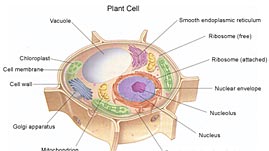Teachers' Domain - Digital Media for the Classroom and Professional Development
User: Preview

Source: Miller and Levine, Biology
As you've probably noticed, there are some striking differences between plants and animals, especially vertebrate animals. But how different are your cells from the cells of a plant? Compare the two images provided and see for yourself.
Cells vary widely in form and function, even within the same organism. The human body, for example, is made up of about two hundred different types of specialized cells, ranging from foot-long nerve cells to tiny, disk-shaped blood cells. At first glance these cells appear to have little in common other than the body or body part that houses them. For all their differences, though, different types of specialized cells have a lot in common. Even plant and animal cells have far more structural similarities than they have differences.
Plant and animal cells have nearly all of the most important cell structures in common. For example, both plant and animal cells have a nucleus, which contains the cell's genetic material, or DNA. Plant and animal cells also have some of the same organelles floating in the cytoplasm, the fluid-filled region between the cell membrane and the nucleus: Mitochondria, the cell's "powerhouses," create energy through the process of aerobic respiration; ribosomes are responsible for synthesizing proteins; the endoplasmic reticulum stores and transports proteins and other compounds within and outside the cell; Golgi bodies transform proteins into more complex molecules; and lysosomes contain as many as 40 different enzymes used to break down large molecules. Indeed, even under a microscope it is difficult to tell apart many plant organelles from the same organelles found in animals.
Despite all their similarities, plant cells and animal cells differ in two important ways. First, plant cells have structures called chloroplasts, and animal cells don't. Chloroplasts are the structures that give leaves their green color and, more importantly, allow plants to acquire their energy from the sun rather than from food, the primary source of energy for animals. Like mitochondria, chloroplasts convert energy from one form to another. However, this process, called photosynthesis, is in many ways the opposite of the mitochondria's aerobic respiration process. In aerobic respiration, food molecules are combined with oxygen to produce energy and carbon dioxide. In photosynthesis, chloroplasts use energy from the sun to convert carbon dioxide and water into food molecules like sugars and other carbohydrates.
All cells have a cell membrane, a structural layer that gives the cell shape, while allowing molecules of various types to pass into and out of the cell. Unlike animal cells, however, plant cells have a cell wall that surrounds the entire cell, including the membrane. The cell wall provides plant cells with a protective covering and gives the plant the rigidity it needs in order to stand up even under pressure from wind, rain, and snow. This wall is made of cellulose and is intricately cross-linked with fibers of other carbohydrate molecules. This structural pattern also allows each cell to withstand the increased internal pressure from osmosis, when the plant absorbs water.
 Loading Standards
Loading Standards Teachers' Domain is proud to be a Pathways portal to the National Science Digital Library.
Teachers' Domain is proud to be a Pathways portal to the National Science Digital Library.
